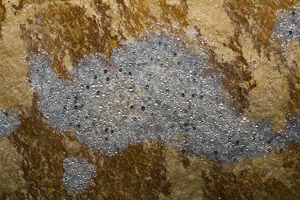There are many species of bacteria found in the cave environment, most of which you will not notice as they are individually minute. Between them they have a variety of lifestyles including saprophytes (live on dead organic matter), pathogens (cause disease), chemoautotrophs (obtain energy by oxidising or reducing iron and sulphur compounds), nitrifying bacteria (oxidise ammonia to nitrite or nitrate, using carbon dioxide as their sole carbon source).
Chemoautotrophic bacteria obtain energy by the oxidation or reduction of simple inorganic substances (e.g. iron, sulphur, nitrogen). They only need simple inorganic elements to survive e.g. iron or sulphur, moisture, carbon dioxide and a few trace elements to survive, they do not need sunlight like green plants. In British mines (and caves) Ferrobacillus ferrooxidans uses carbon dioxide as its carbon source and oxidizes iron to obtain energy. Sulphur reducing and oxidizing bacteria are usually found near shale rock containing pyrite.
Nitrifying bacteria oxidize ammonia to nitrite e.g. Nitrosomonas, or nitrate e.g. Nitrobacter. This oxidation process is their source of energy, they obtain carbon from carbon dioxide. The energy produced is very small but they are extremely efficient at this process, most of the energy goes towards fixing carbon so there is not much left for growth. They secrete a sticky slime matrix which they use to attach themselves to a substrate such as gravel or flowstone. They cannot survive desiccation so the damp underground environment suits the group. Nitrobacter oxidise ammonia to nitrous and nitric acid that can dissolve limestone.
Other bacteria that have been found in caves include the Gram-negative aerobic Clostridium and Azobacter that are able to obtain nitrogen from the air and convert it into nitrogen compounds.
These bacteria are probably crucial to the survival of other cave dwellers deep in a cave (such as the shrimp Niphargus) as they are at the base of the food chain.
As well as the chemoautotroph bacteria there are many species that feed heterotrophically on ready made organic material. Heterotrophic filamentous bacteria have been found growing on flowstone in caves. Where these bacteria obtain their source of organic food is not clear. For cavers the most important heterotroph is the spirochaete Leptospira interrogans which causes Weil’s disease. There are over 180 strains of this bacterium, the most serious infections are carried by the brown rat. 9% of British cavers carry antibodies demonstrating some prior contact with the pathogen, although most infections do not develop into Weil’s disease.
Weil's disease is caught by direct or indirect exposure to rat urine. Rats are a host animal for Leptospira interrogan var Icterohaemorrhagiae bacteria. High numbers of these bacteria can be present in the kidneys of the rat (100,000,000,000-bacteria/per gram). The bacteria pass out into the environment when the rats urinate and cavers can then be infected by contact with contaminated water or moist soil. The Leptospires enter the caver's body through cuts and abrasions, also via the mucous membranes of the nose, mouth or eyes. Luckily rats do not generally live in caves as there is not enough food, you are most likely to see them if the cave is in very close proximity to a farm. Cavers should be aware of the potential for Weil’s infection in some caves on the Mendips that receive water from surface farm yards, including Manor Farm Swallet and Priddy Green Sink.
The disease is biphasic - the first phase (4-14 days after infection) is much like flu, after an apparent recovery the victim then suffers from a variety of symptoms including meningitis, liver damage and renal failure. Most infections do not develop into Weil’s disease, the small number that do can kill if not treated. Diagnosis of the disease is difficult as symptoms are so varied, there is no vaccination available.
Actinomyctes are mouldlike filamentous bacteria – they are often responsible for the damp mouldy smell in caves. Some possess antibiotic properties which may be why moonmilk has been used as a wound dressing and cavers with colds report cold symptoms disappearing underground. Some Actinomycetes synthesise carotene – the brown colour it produces is responsible for the brown colour of certain cave insects. The sparkling yellow and silver patches on the walls just beyond the limit of light are thought to be a combination of a fungus and a bacteria. It could be a species of actinomycete. The sparkling effect is due to drops of condensation reflecting your cave light.
A Cyanobacteria (formerly known as as Blue-green algae due to a blue photosynthetic pigment) called Synechococcus elongatus is associated with moonmilk, possibly involved in the conversion of limestone to moonmilk. Analysis of moonmilk shows it consists of a complex of unusual magnesium and calcium carbonates with an abundant amount of organic matter within it, mostly made up of bacteria such as Macromonas bipunctata as well as actinomycetes and algae. The blue-green algae found in the dark zone of caves must use different metabolic pathways from those on the surface which require light. A blue-green algae Anacystis montana is often found near the lights in show caves.
A brown jelly like cyanobacter seen outside cave entrances is Nostoc sp. This occurs as both a free living cyanobacter and in association with a fungi to form a lichen. When wet it swells up hence its name, jelly lichen. It is a photobiont that cannot survive on acidic rocks like granite and quartzite
|


